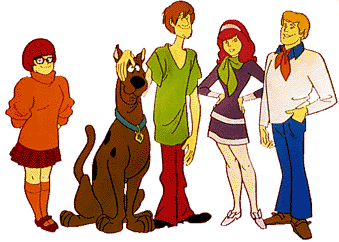![[MetroActive Arts]](/gifs/art468.gif)
![[MetroActive Arts]](/gifs/art468.gif)
[ Arts Index | Sonoma County Independent | MetroActive Central | Archives ]
Scooby Doo: Icon of a Generation?
By Joab Jackson
Douglas Coupland? Douglas Rushkoff? Who needs 'em? Their thinly written books and $7,500-an-hour speaking engagements scarcely explain Generation X. No, the key to understanding this lost generation lies in a cartoon series about four teenage slackers and one dog wandering the globe in a multicolored van. Get Scooby and you get Gen X.
Oh, sure, it may be hard to believe Scooby-Doo, Where Are You? is anything more than fodder for a good drinking game (The Unofficial Scooby Doo Drinking Game). But as the longest-running continuously produced children's cartoon show, Scooby-Doo provided role models for countless children.
And what models they were! One may not find much evidence of their multilayered resonance at the official Scooby-Doo Web site (Scooby Doo on TBS).
To get beyond the obvious, one must venture to the fans' Web sites, where speculation and gossip intermingle with fact to reveal deeper truths. A mythology has built up around the gang, and it encompasses several fan-shared truisms only hinted at in the show itself. Here are the main ones:
Scooby and Shaggy are stoners: Shaggy's goatee and pale skin? Scoob's hyperactivity and the ability to see ghosts long before anyone else? You don't need to be a rehab counselor to see how toasty Scoob and Shag are. Ten Reasons Why Scooby Doo Was a Drug-Influenced Cartoon notes these two "always had the munchies" and "were always giddy and laughing."
In Scooby Doo, an Analysis, Seth Macy speculates that Shaggy "would work the slide on Shaggy's bong when they would pull tubes in the back of the Mystery Machine." Hmmm, perhaps Macy saw a different show from the rest of us.
But what the hell was that "Mystery Machine" they traveled around in, anyway, if not a hippie bus?
As for those Scooby Snacks, one anonymously penned Scooby site has it that they are, in fact, hash brownies: "Whenever Scooby, or Shaggy for that matter, eats a Scooby Snack, they go ape! It just blows their mind and they do whatever they are told, because they are so lit!"
Fred and Daphne are lovers: Fred has the buff bod, Daphne is the leggy redhead, and it was obvious to any kid with an older sibling that these two are just itching to get alone. In almost every show, Fred says, "Let's split up, gang," sending Velma, Scooby, and Shaggy off to find some clues.
What happens next depends on who does the telling. Here is what the official TBS site claims: "[Fred] and Daphne search for information." Here is what the anonymous Scooby site concludes: "It's no real mystery what these two are really doing--they're getting busy in the back of the Mystery Machine." Mark Dorr, Tim Solley, and Chad Holder, creators of the Web site Scooby Doo: Lost Voice of Generation X, concur: "Fred and Daphne went to try to wear out the warranty on the shocks on the Mystery Machine."
Velma is a lesbian: The evidence that this logic-minded bespectacled character being a closet case may be pretty weak (Dorr et al. offer only that in hundreds of episodes "Velma never had even one romantic interest"), but it's accepted as fact in most quarters. In Where the Gang Is Now, Joey Carlton fantasizes that after leaving the ghost-chasing business, "Velma was grocery shopping one day when she met the woman of her dreams. She was whisked off her feet and right into the middle of the gay-rights movement. Velma now lives in lovely San Francisco with her loving wife, Martina, and their two adopted children, Brian and Kate."
Interestingly enough, it was Velma, not Daphne, who's become the group's female pop icon. It was Velma who got her own Web page (Mmmmm ... Sweet Velma). And it was Velma who came in 95th in a Foxy zine poll of coolest girls, beating out Camille Paglia (96), the original staff of Sassy (98), and the band L7 (104).
Velma gay? Shag a stoner? Is this some sort of group hallucination? We're talking about a Saturday-morning cartoon. You gotta admit, though, that there's more happening here than Hanna-Barbera lets on. Perhaps the best explanation of Scooby's influence comes from Laura Laytham, who, in her Web page A Marxist Reading of Scooby Doo, argues that Scooby and the gang helped little TV viewers understand the changing world around them. Scooby debuted in culturally tumultuous 1969; as Laytham has it, the show's unusual but friendly characters made their real-life counterparts more accessible. Scooby-Doo "taught our generation to accept what had decades before been seen as entirely unacceptable," she concludes. "Without a doubt, the Scooby-Doo cartoon greatly contributed liberality to its audience."
So, if not for those meddling kids, an entire generation would be more way conservative than it is. Zoiks!
[ Sonoma County Independent | MetroActive Central | Archives ]
Copyright © Metro Publishing Inc. Maintained by Boulevards New Media.

Research assistance: David Cassel.
Web exclusive to the August 14-20, 1997 issue of the Sonoma County Independent.